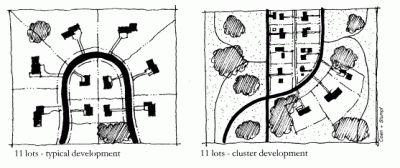(This is the third in a series of posts about last week’s open meeting on zoning review. A group of residents and committee members who assembled at the Town House were asked five questions related to zoning. I’ll cover one question each day this week. Up today is subdivisions.)
The town calls them major residential developments, but you know them better as subdivisions. And they’re a way of life in Southborough.
Drive through any number of neighborhoods in Southborough and you’ll see the same thing: a collection of houses each on a large lot with plenty of space between them. But a different approach called cluster development, could change the look of subdivisions in Southborough.
In a cluster development, houses are packed more tightly together on smaller lots in order to preserve a larger parcel of land as shared open space. The open space can be used for recreation or for the protection of wildlife habitat.

The question before residents at last week’s zoning review meeting was, “Is the town willing to offer incentives to encourage cluster development?”
A common incentive towns use is to offer a density bonus that lets developers pack houses more tightly on a parcel of land. Developers benefit because they get to sell more houses in the end. And it means cluster development comes with a trade-off: you get more houses and more open space as compared to convention subdivisions which have fewer houses and less open space.
One resident at the zoning meeting wondered how many more residents the town wants. “Does each new resident cost the town more money in services than we get back in revenue?” he asked.
Another resident commented that cluster developments have fewer roads to maintain and plow.
Others saw clustered developments as a way to encourage more affordable housing. “Right now we have a density bonus for affordable housing. Short of 40B this is the town’s only vehicle for affordable housing.”

